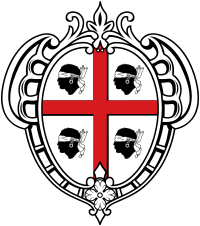Sardinian people
The Sardinians,[5] or Sards[6] (Sardinian: Sardos or Sardus; Italian and Sassarese: Sardi; Gallurese: Saldi), are a Romance[7][8] ethnic group native to Sardinia,[9][10][11][12] from which the western Mediterranean island and autonomous region of Italy derives its name.[13][14]
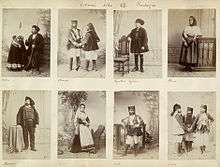 Sardinian people and their traditional regional attires in 1880s | |
| Regions with significant populations | |
| 1,661,521 (Inhabitants of Sardinia inclusive of all ethnicities)[1] | |
| Languages | |
| Italian[2] • Sardinian[3] | |
| Religion | |
| Mostly Christian (Roman Catholicism[4]) |
Etymology

Not much can be gathered from the classical literature about the origins of the Sardinian people.[16] The ethnonym "S(a)rd" belongs to the Pre-Indo-European linguistic substratum, and whilst they might have derived from the Iberians,[17][18] the accounts of the old authors differ greatly in this respect. The oldest written attestation of the ethnonym is on the Nora stone, where the word Šrdn (Shardan[19]) bears witness to its original existence by the time the Phoenician merchants first arrived to the Sardinian shores.[20][17] According to Timaeus, one of Plato's dialogues, Sardinia and its people as well, the "Sardonioi" or "Sardianoi" (Σαρδονιοί or Σαρδιανοί), might have been named after "Sardò"[17] (Σαρδώ), a legendary Lydian woman from Sardis (Σάρδεις), in the region of western Anatolia (now Turkey).[21][22][23] Some other authors, like Pausanias and Sallust, reported instead that the Sardinians traced their descent back to a mythical ancestor, a Libyan son of Hercules or Makeris[24] (related either to the Berber verb Imɣur "to grow",[25] to the specific Kabyle word Maqqur "He is the greatest", or also associated with the figure of Melqart[26]) revered as a deity going by Sardus Pater Babai[27][28] ("Sardinian Father" or "Father of the Sardinians"), who gave the island its name.[29][30][31][32][33][34] It has also been claimed that the ancient Nuragic Sards were associated with the Sherden (šrdn in Egyptian), one of the Sea Peoples.[35][36][37][34][38][18][39][40][41][42] The ethnonym was then romanised, with regard for the singular masculine and feminine form, as sardus and sarda.
History
Prehistory
Sardinia was first colonized in a stable manner during the Upper Paleolithic and the Mesolithic by people from the Iberian and the Italian peninsula. During the Neolithic period and the Early Eneolithic, people from Italy, Spain and the Aegean area settled in Sardinia. In the Late Eneolithic-Early Bronze Age the "Beaker folk" from Southern France, Northeastern Spain and then from Central Europe[43] settled on the island, bringing new metallurgical techniques and ceramic styles and probably some kind of Indo-European speech.[44]
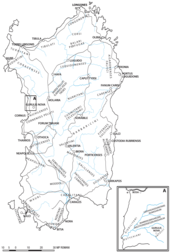
Nuragic civilization
The Nuragic civilization arose in the Middle Bronze Age, during the Late Bonnanaro culture, which showed connections with the previous Beaker culture and the Polada culture of northern Italy. Although the Sardinians were considered to have acquired a sense of national identity,[45] at that time, the grand tribal identities of the Nuragic Sardinians were said to be three (roughly from the South to the North): the Iolei/Ilienses, inhabiting the area from the southernmost plains to the mountainous zone of eastern Sardinia (later part of what would be called by the Romans Barbaria);[46][47] the Balares, living in the North-West corner;[48] and finally the Corsi stationed in today's Gallura and the island to which they gave the name, Corsica.[49] Nuragic Sardinians have been connected by some scholars to the Sherden, a tribe of the so-called Sea Peoples, whose presence is registered several times in ancient Egyptian records.[50]
The language (or languages) spoken in Sardinia during the Bronze Age is unknown, since there are no written records of such period. According to Eduardo Blasco Ferrer, the Proto-Sardinian language was akin to Proto-Basque and the ancient Iberian, while others believe it was related to Etruscan. Other scholars theorize that there were actually various linguistic areas (two or more) in Nuragic Sardinia, possibly Pre–Indo-Europeans and Indo-Europeans.[51]
Antiquity
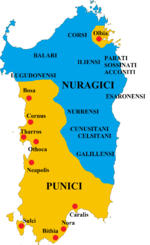
In the 9th century BC, the Phoenicians founded cities and ports along the southern and western coast, such as Karalis, Bithia, Sulki and Tharros;[52] starting from the same areas, where the relations between the indigenous Sardinians and the Phoenician settlers had been so far peaceful,[53] the Carthaginians proceeded to annex the Southern and Western part of Sardinia in the late 6th century BC. Well into the 1st century B.C., the native Sardinians were said to have preserved many cultural affinities with the ancient Punic-Berber populations from the North African Mainland.[54]
After the First Punic War, the whole island was conquered by the Romans in the 3rd century BC. Sardinia and Corsica were then made into a single province;[55] however, it took the Romans more than another 150 years to manage to subdue the more belligerent Nuragic tribes of the interior,[56] and after 184 years since the Sardinians fell under Roman sway, Cicero noted how there was still not on the island a single community which had had friendly intercourse with the Roman people.[57][58][12] Even from the former Sardo-Carthaginian settlements, with which the Sardinian mountaineers had formed an alliance in a common struggle against the Romans[59], emerged indigenous attempts at resisting cultural and political assimilation; Punic-style magistrates, the sufetes, wielded local control in Nora and Tharros through the end of the first century B.C., although two sufetes existed in Bithia as late as the mid-second century CE.[60]
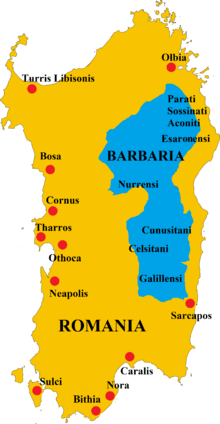
During the Roman rule, there was a considerable immigration flow from the Italian peninsula into the island; ancient sources mention several populations of Italic origin settling down in Sardinia, like the Patulcenses Campani (from Campania), the Falisci (from southern Etruria), the Buduntini (from Apulia) and the Siculenses (from Sicily); Roman colonies were also established in Porto Torres (Turris Libisonis) and Uselis.[61] The Italic immigrants were confronted with a difficult coexistence with the natives,[62] who were reluctant to assimilate to the language and customs of the colonists; many aspects of the ancient Sardo-Punic culture are documented to have persisted well into Imperial times, and the mostly mountainous innerlands came to earn the name of Barbaria ("Land of the Barbarians", similar in origin to the word Barbary) as a testament of the fiercely independent spirit of the tribes who dwelled therein (in fact, they would continue to practice their indigenous prehistoric religion up until the age of Pope Gregory I).[63] Nevertheless, Sardinia would eventually undergo cultural Romanization, the modern Sardinian language being one of the most evident cultural developments thereof.[64][65][66] Strabo gave a brief summary about the Mountaineer tribes,[67] living in what would be called civitates Barbariae, Geographica V ch.2:
There are four nations of mountaineers, the Parati, Sossinati, Balari, and the Aconites. These people dwell in caverns. Although they have some arable land, they neglect its cultivation, preferring rather to plunder what they find cultivated by others, whether on the island or on the continent, where they make descents, especially upon the Pisatæ. The prefects sent [into Sardinia] sometimes resist them, but at other times leave them alone, since it would cost too dear to maintain an army always on foot in an unhealthy place.
Middle Ages
After the fall of the Western Roman Empire, Sardinia was ruled in rapid succession by the Vandals,[68] the Byzantines, the Ostrogoths[69] and again by the Byzantines.
During the Middle Ages, the "Sardinian Nation" (Nació Sarda or Sardesca, as reported from the native and Aragonese dispatches[70]) was juridically divided into four independent Kingdoms (known individually in Sardinian as Judicadu, Giudicau or simply Logu, that is "place";[71] in Italian: Giudicato);[72] all of them, with the exception of Arborea, fell under the influence of the Italian maritime republics of Genoa and Pisa, as well as some noble families from the two cities, like the Dorias and the Della Gherardescas. The Dorias founded the cities of Alghero and Castelgenovese (today Castelsardo), while the Pisans founded Castel di Castro (today Cagliari) and Terranova (today Olbia); the famous count Ugolino della Gherardesca, quoted by Dante Alighieri in his Divine Comedy, favored the birth of the mining town of Villa di Chiesa (today Iglesias), which became an Italian medieval commune along with Sassari and Castel di Castro.
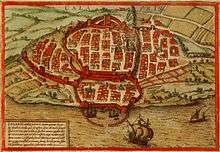
Following the Aragonese conquest of the Sardinian territories under Pisan rule, which took place between 1323 and 1326, and then the long conflict between the Aragonese Kingdom and the Judicate of Arborea (1353–1420), the newborn Kingdom of Sardinia became one of the Associate States of the Crown of Aragon. The Aragonese repopulated the cities of Castel di Castro and Alghero with Spaniards, mainly Catalans.[73][74] A local dialect of Catalan is still spoken by a minority of people in the city of Alghero.
Modern and contemporary history
In the 16th and 17th centuries, the main Sardinian cities of Cagliari (the capital of the Kingdom), Alghero and Sassari appear well placed in the trade routes of the time. The cosmopolitan composition of its people provides evidence of it: the population was not only indigenous, but also hailing from Spain, Liguria, France and the island of Corsica in particular.[75][76][77] Especially in Sassari and across the strip of territory that goes from Anglona to Gallura, the Corsicans became the majority of the population at least since the 15th century.[77] This migration from the neighboring island, which is likely to have led to the birth of the Tuscan-sounding Sassarese and Gallurese dialects,[77] went on continuously until the 19th century.
The Spanish era ended in 1713, when Sardinia was ceded to the Austrian House of Habsburg, followed with another cession in 1718 to the Dukes of Savoy, who assumed the title of "Kings of Sardinia" and ruled the island from Turin, in Piedmont. During this period, Italianization policies were implemented, so as to assimilate the islanders to the then Savoyard mainland (stati di terraferma).[78] In 1738, the Ligurian colonists escaped from Tabarka (Tunisia) were invited by Charles Emmanuel III to settle on the little islands of San Pietro and Sant'Antioco (at Carloforte and Calasetta), in the south-west area of Sardinia, bringing with them a Ligurian dialect called "Tabarchino", still widely spoken there.[79] Then, the Piedmontese Kingdom of Sardinia annexed the whole Italian peninsula and Sicily in 1861 after the Risorgimento, becoming the Kingdom of Italy.

Since 1850, with the reorganization of the Sardinian mines, there had been a considerable migration flow from the Italian peninsula towards the Sardinian mining areas of Sulcis-Iglesiente; these Mainland miners came mostly from Lombardy, Piedmont, Tuscany and Romagna.[80][81] According to an 1882 census realised by the French engineer Leon Goüine, 10.000 miners worked in the south-western Sardinian mines, one third of whom being from the Italian mainland;[82] most of them settled in Iglesias and frazioni .
At the end of the 19th century, communities of fishermen from Sicily, Torre del Greco (Campania) and Ponza (Lazio) migrated on the east coasts of the island, in the towns of Arbatax/Tortolì, Siniscola and La Maddalena.
In 1931, only 3,2% of the island's population was estimated to be native of the Mainland.[83] A central government policy would change this situation in the following years,[83] which saw an immigration flow from the Italian peninsula: the Fascist regime resettled to Sardinia a number of Italians from a wide variety of regions like Veneto, Marche, Abruzzo and Sicily, who were encouraged to found settlements of their own like the new mining town of Carbonia, or villages like Mussolinia di Sardegna ("Sardinia's Mussolinia", now Arborea) and Fertilia; after World War II, Italian refugees from the Istrian exodus were relocated in the Nurra region, along the north-western coastline. As a result of the city's originally diverse composition, Carbonia developed a variety of Italian with some Sardinian influences from the neighbouring areas, while the other mainland coloni ("colonists") establishing minor centres kept their dialects of Istriot, Venetian and Friulan, which are still spoken by the elderly.[84] In the same period, a few Italian Tunisian families settled in the sparsely populated area of Castiadas, east of Cagliari.[85]
Following the Italian economic miracle, a historic migratory movement from the inland to the coastal and urban areas of Cagliari, Sassari-Alghero-Porto Torres and Olbia, where today most Sardinians live, took place.
Demographics
With a population density of 69/km2,[86] slightly more than a third of the national average, Sardinia is the fourth least populated region in Italy. The population distribution is anomalous compared to that of other Italian regions lying on the sea. In fact, contrary to the general trend, urban settlement has not taken place primarily along the coast but towards the centre of the island. Historical reasons for this include the repeated Moorish raids during the Middle Ages, which made the coast unsafe, widespread pastoral activities inland, and the swampy nature of the coastal plains that were reclaimed only in the 20th century. The situation has been recently reversed with the expansion of seaside tourism; today all Sardinia's major urban centres are located near the coast, while the island's interior is very sparsely populated.
It is the region of Italy with the lowest total fertility rate[87][88] (1.087 births per woman), and the region with the second-lowest birth rate.[89] However, the population in Sardinia has increased in recent years because of immigration, mainly proceeding from continental Italy and Sicily, but also from Eastern Europe (esp. Romania), Africa and Asia.
As of 2013, there were 42.159 foreign (that is, any people who have not applied for Italian citizenship) national residents, forming 2.5% of the total population.[90]
Life expectancy and longevity
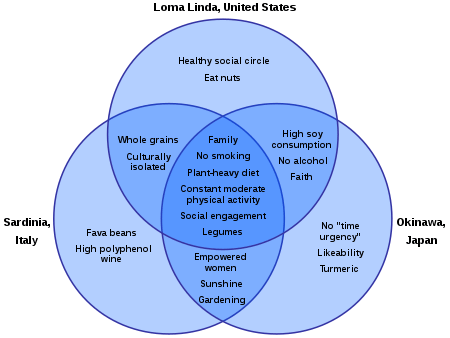
Average life expectancy is slightly over 82 years (85 for women and 79.7 for men[91]).
Sardinia is the first discovered Blue Zone, a demographic and/or geographic area of the world where people live measurably longer lives.[92] Sardinians share with the Ryukyuans from Okinawa[93][94] (Japan) the highest rate of centenarians in the world (22 centenarians/100,000 inhabitants). The key factors of such a high concentration of centenarians are identified in the genetics of the Sardinians,[95][96][97] lifestyle such as diet and nutrition, and the social structure.[98]
Demographic indicators
- Birth Rate: 8.3 (per 1,000 inhabitants – 2005) [99]
- Fertility Rate: 1.07 (births per woman – 2005) [100]
- Mortality rate: 8.7 (per 1,000 inhabitants – 2005) [99]
- Infant mortality rate males: 4.6 (per 1,000 births- 2000) [101]
- Infant mortality rate females: 3.0 (per 1,000 births – 2000) [101]
- Marriage rate: 2.9 (per 1,000 inhabitants – 2014) [102]
- Suicide rate males: 20.4 (per 100,000 inhabitants)[103][104][105]
- Suicide rate females: 4.5 (per 100,000 inhabitants)[103][104][105]
- Total literacy rate: 98.2%[106][107]
- Literacy rate under 65 years old: 99.5%[106][107]
Historical population
| Year | Pop. | ±% |
|---|---|---|
| 1485 | 157,578 | — |
| 1603 | 266,676 | +69.2% |
| 1678 | 299,356 | +12.3% |
| 1688 | 229,532 | −23.3% |
| 1698 | 259,157 | +12.9% |
| 1728 | 311,902 | +20.4% |
| 1751 | 360,805 | +15.7% |
| 1771 | 360,785 | −0.0% |
| 1776 | 422,647 | +17.1% |
| 1781 | 431,897 | +2.2% |
| 1821 | 461,931 | +7.0% |
| 1824 | 469,831 | +1.7% |
| 1838 | 525,485 | +11.8% |
| 1844 | 544,253 | +3.6% |
| 1848 | 554,717 | +1.9% |
| 1857 | 573,243 | +3.3% |
| 1861 | 609,000 | +6.2% |
| 1871 | 636,000 | +4.4% |
| 1881 | 680,000 | +6.9% |
| 1901 | 796,000 | +17.1% |
| 1911 | 868,000 | +9.0% |
| 1921 | 885,000 | +2.0% |
| 1931 | 984,000 | +11.2% |
| 1936 | 1,034,000 | +5.1% |
| 1951 | 1,276,000 | +23.4% |
| 1961 | 1,419,000 | +11.2% |
| 1971 | 1,474,000 | +3.9% |
| 1981 | 1,594,000 | +8.1% |
| 1991 | 1,648,000 | +3.4% |
| 2001 | 1,632,000 | −1.0% |
| 2011 | 1,639,362 | +0.5% |
| Source: ISTAT 2011, – D.Angioni-S.Loi-G.Puggioni, La popolazione dei comuni sardi dal 1688 al 1991, CUEC, Cagliari, 1997 – F. Corridore, Storia documentata della popolazione di Sardegna, Carlo Clausen, Torino, 1902 | ||
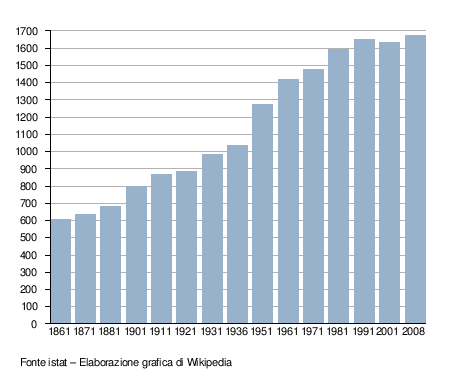
Division by gender and age
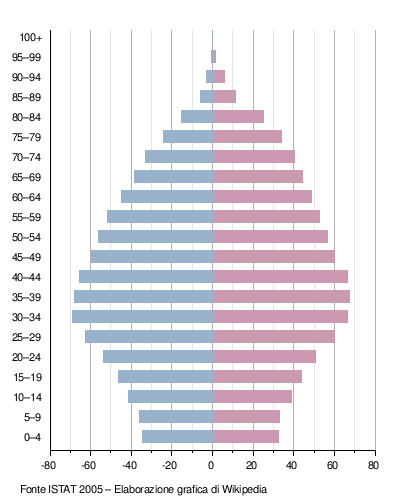
Total population by age
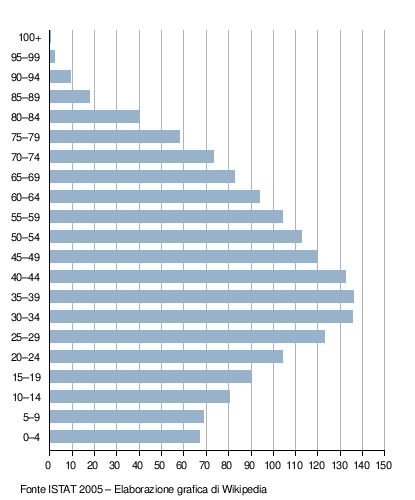
Geographical distribution
Most Sardinians are native to the island but a sizable number of people have settled outside Sardinia: it had been estimated that, between 1955 and 1971, 308,000 Sardinians have emigrated to the Italian mainland.[108] Sizable Sardinian communities are located in Piedmont, Liguria, Lombardy, Tuscany and Latium.
Sardinians and their descendants are also numerous in Germany, France, Belgium, Switzerland and the USA (part of the Italian-American community). Almost all the Sardinians migrating to the Americas settled down in the Southern part of the continent, especially in Argentina (between 1900 and 1913 about 12,000 Sardinians lived in Buenos Aires and neighbourhoods)[109] and Uruguay (in Montevideo in the 1870s lived 12,500 Sardinians). Between 1876 and 1903, 92% of the Sardinians that moved towards the Americas settled in Brazil.[110] Between 1876 and 1925 34,190 Sardinians migrated to Africa, in particular towards the then French Algeria and Tunisia.[110] Small communities with Sardinians ancestors, about 5000 people, are also found in Brazil (mostly in the cities of Belo Horizonte, Rio de Janeiro and São Paulo),[111] the UK, and Australia.
The Region of Sardinia keeps a register of overseas Sardinians that managed to set up, in the Italian mainland and the rest of the world, a number of cultural associations: these are meant to provide the people of Sardinian descent, or those with an interest on Sardinian culture, an opportunity to enjoy a wide range of activities. As of 2012, there are 145 clubs registered on it.[112]
| Sardinians residing in European countries 2008[113] | |
| Germany | 27,184 |
| France | 23,110 |
| Belgium | 12,126 |
| Switzerland | 7,274 |
| Netherlands | 6,040 |
| Others | 17,763 |
| Total | 93,497 |
Unlike the rest of Italian emigration, where migrants were mainly males, between 1953–1974 an equal number of females and males emigrated from Sardinia to the Italian mainland.
Surnames and given names
The most common Sardinian surnames, like Sanna (fang[114]), Piras (pears[115]), Pinna (feather, pen[116]) and Melis (honey[117]),[118][119] derive from the Sardinian language and developed in the Middle Ages as a result of being registered in documents like the condaghes for administrative purposes; most of them derive either from Sardinian place names[120] (e.g. Fonnesu "from Fonni",[121] Busincu "from Bosa" etc.), from animal names[120] (e.g. Porcu "pig", Piga "magpie",[122] Cadeddu "puppy" etc.) or from a person's occupation, nickname[123] (e.g. Pittau "Sebastian"[124]), distinctive trait (e.g. Mannu "big"), and filiation (last names ending in -eddu which could stand for "son of", e.g. Corbeddu "son/daughter of Corbu"[124]); a number of them have undergone Italianization over the most recent centuries (e.g. Pintori, Scano, Zanfarino, Spano, etc.).[125] Some local surnames also derive from terms of the Paleo-Sardinian substrate.[121] The largest percentage of last names originating from outside the island is from Southern Corsica[126][127] (like Cossu,[128] Cossiga,[129] Alivesi and Achenza, originally from the towns of Olivese and Quenza respectively[130]), followed by Italian (especially Piedmontese but also Campanian, Sicilian and Ligurian, originating from the days of the Savoyard rule and the assimilation policy:[131][132] some of them have been "Sardinianized", like Accardu, Calzinu, Gambinu, Raggiu, etc.[125]) and Spanish (especially Catalan) surnames.
| Most common surnames | |
| 1 | Sanna |
| 2 | Piras |
| 3 | Pinna |
| 4 | Serra |
| 5 | Melis |
| 6 | Carta |
| 7 | Manca |
| 8 | Meloni |
| 9 | Mura |
| 10 | Lai |
| 11 | Murgia |
| 12 | Porcu |
| 13 | Cossu |
| 14 | Usai |
| 15 | Loi |
| 16 | Marras |
| 17 | Floris |
| 18 | Deiana |
| 19 | Cocco |
| 20 | Fadda |
The Sardinian personal names (like Baínzu "Gavin", Bachis "Bachisius", Bobore "Salvator", Iroxi "George", Chìriga "Cyrica", Elianora "Eleanor", Boele "Raphael", Sidore "Isidore", Tiadora "Theodora", etc.) are historically attested and were common among the islanders up until the contemporary era, when they switched in full measure to the Italian names.
Self-identification
Population surveys have been carried out, on repeated occasions, to provide information about the Sardinians' identity, as well as their modern conciliation with those related to the institutional layers of political governance. The most detailed survey, conducted by the University of Cagliari and Edinburgh, made use of a Moreno Question which gave the following results: (1) just Sardinian, 26%; (2) more Sardinian than Italian, 37%; (3) equally Sardinian and Italian, 31%; (4) more Italian than Sardinian, 5%; (5) only Italian and not Sardinian, 1%.[133][134][135] A 2017 poll by the Ixè Institute reported that 51% of the Sardinians questioned identified themselves as Sardinian (as opposed to an Italian average of 15% who identified by their region of origin) rather than Italian (19%), European (11%), and/or citizen of the world (19%).[136][137]
Culture
Languages
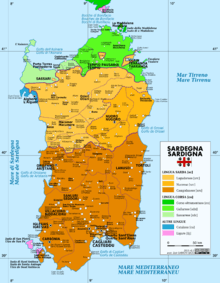
Italian (italiano) was first introduced to Sardinia by the House of Savoy in July 1760[138][139][140][141][142][143] and is the most commonly spoken language nowadays, albeit in a regional variety, as a result of language shift and assimilation waves that facilitated cultural Italianization.[144]
On the other hand, Sardinian (sardu)[5] has been the historical language of the indigenous Sards[145][146][147] ever since Latin supplanted the Pre-Indo-European Paleo-Sardinian. The historical loss of the islanders' political autonomy has kept the language at a stage of dialectal fragmentation, reflecting the coexistence of the various other languages (namely Catalan, Spanish, and finally Italian) imposing themselves in a position of political and thereby social prestige.[148] Because of a movement, described by some authors like a "linguistic and cultural revival" that gained traction in the postwar period,[149][150] the Sardinians' cultural heritage was recognized in 1999, which makes them the largest ethnolinguistic minority group in Italy, with around a million Sardinians still able to speak the language.[151][152][153][154] However, because of a rather rigid model of Italian education system that strongly promoted Italian to the detriment of Sardinian,[155] the language has been in decline over the past century,[156] since the people effectively retaining Sardinian have gradually become a small minority in their own island (in fact, most Sardinians are linguistically and culturally Italianized nowadays, and it has been estimated that only 10 percent of the young native population has some active and passive competence in the language[157][158]). Therefore, Sardinian is facing challenges analogous to other definitely endangered minority languages across Europe,[159] and its two main Logudorese and Campidanese varieties, as defined by their standard orthographies, have been designated as such by UNESCO.[160]
The other languages spoken in Sardinia, all also endangered but with much fewer speakers than Sardinian, developed after the contact with certain communities from outside the island, namely Corsicans, Catalans and Italians from Genoa and Pisa, settling in specific regions of Sardinia over the recent centuries;[161] because of these dynamics, Sardinia's society has been characterized by situational plurilingualism since the late Middle Ages.[162] These languages include Sassarese (sassaresu) and Gallurese (gadduresu), which are of remote Corso-Tuscan origin but often socially associated with Sardinian,[163][164] Algherese Catalan (alguerés), and Ligurian Tabarchino (tabarchin).
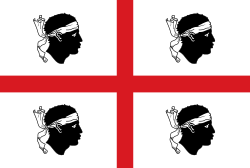
Flag
The so-called flag of the Four Moors is the historical and official flag of Sardinia. The flag is composed of the St George's Cross and four Moor's heads wearing a white bandana in each quarter. Its origins are basically shrouded in mystery, but it is presumed it originated in Aragon to symbolize the defeat of the Moorish invaders in the battle of Alcoraz.[165]
Sardinia's Day
Sa die de sa Sardigna ("Sardinia's Day" in English) is a holiday celebrated each 28 April to commemorate the revolt occurring from 1794 to 1796 against the feudal privileges, and the execution or expulsion of the Savoyard officials (including the then Piedmontese viceroy, Carlo Balbiano) from Sardinia on 28 April 1794. The revolt was spurred by the King's refusal to grant the island the autonomy the locals demanded in exchange for defeating the French.[166][167][168][169] The holiday has been formally recognised by the Sardinian Council since 14 September 1993.[170] Some public events are annually held to commemorate the episode, while the schools are closed.
Religion

The vast majority of the Sardinians are baptized as Roman Catholic, however church attendance is one of the lowest in Italy (21.9%).[171] Our Lady of Bonaria is the Patroness Saint of Sardinia.
Traditional clothes
Colourful and of various and original forms, the Sardinian traditional clothes are an ancient symbol of belonging to specific collective identities, as well as one of the most genuine ethnic expressions of the Mediterranean folklore.[172] Although the basic model is homogeneous and common throughout the island, each town or village has its own traditional clothing which differentiates it from the others. The Sardinians' traditional garments, as well as their feminine jewellery,[173] have been defined as an object of study in ethnography since the late 19th century,[174] at a time in which they first started to be slowly displaced in favour of the "Continental fashion" in the various contexts of everyday life, and their primary function switched to become a marker of ethnic identity.[175][176]
In the past, the clothes diversified themselves even within the communities, performing a specific function of communication as it made it immediately clear the marital status and the role of each member in the social area. Until the mid-20th century the traditional costume represented the everyday clothing in most of Sardinia, but even today in various parts of the island it is possible to meet elderly people dressed in costume.
The materials used for their packaging are among the most varied, ranging from the typical Sardinian woollen fabric (orbace) to silk and from linen to leather. The various components of the feminine apparel are: the headgear (mucadore), the shirt (camisa), the bodice (palas, cossu), the jacket (coritu, gipone), the skirt (unnedda, sauciu), the apron (farda, antalena, defentale). Those of the male are: the headdress (berrita), the shirt (bentone or camisa), the jacket (gipone), the trousers (cartzones or bragas), the skirt (ragas or bragotis), the overcoat (gabbanu and colletu), and finally the piece of clothing most associated with the Sardinians, the mastruca, a sheep or goatskin leather jacket without sleeves: "Sardi pelliti" and "mastrucati latrones"[177] "[Sardinian] thieves with rough wool cloaks" were names by which Cicero and other authors mentioned the Sardinians.[178]
Cuisine
Music
Genetics
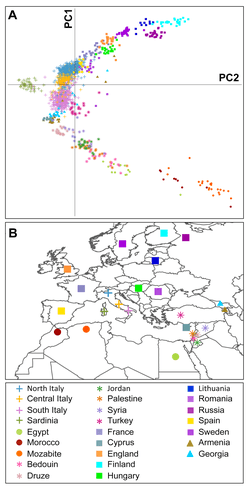
Sardinians, while being part of the European gene pool, are well-known outliers in the European genetic landscape[179][180] (together with the Basques, the Sami and the Icelanders[181]). Two studies analyzing the DNA of ancient individuals from the island confirm that the current population is partly derived from the Early Neolithic Farmers,[95], who remained isolated from major Bronze Age migration occurring on the mainland Indo-European migrations, plus some contribution of the historical colonizers, with most Neolithic ancestry being found in the region of Ogliastra.[182][183] Several studies have been carried out on the genetics of the Sardinian population to investigate some pathologies to which the Sardinians seem to be predisposed in a unique way, likely linked due to founder effects and genetic drift of this island population,[184][185][186] like diabetes mellitus type 1,[187] beta thalassemia and favism,[188] multiple sclerosis[189][190] and coeliac disease. Some other genetic peculiarities have been noted, like the high frequency of rare uniparental haplotypes,[191] extensive linkage disequilibrium of autosomal markers, high levels of homozygosity,[192] the lowest frequency of RH-negative genes in the Mediterranean, the highest frequency in the world of the MNS*M gene, the highest frequency of HLAB*18 together with some typical African alleles, and the highest frequency of the thalassemia variant β39.[193]
Recent comparisons between the Sardinians' genome and that of some individuals from the Neolithic and the early Chalcolithic, who lived in the Alpine (Oetzi), German, and Hungarian regions, showed considerable similarities between the two populations, while at the same time consistent differences between the prehistoric samples and the present inhabitants of the same geographical areas were noted.[194] From this it can be deduced that, while central and northern Europe have undergone significant demographic changes due to post-Neolithic migrations, presumably from the eastern periphery of Europe (Pontic-Caspian steppe), Southern Europe and Sardinia in particular were affected less; Sardinians appear to be the population that has best preserved the Neolithic legacy of Western Europe.[195][196][197][198][199][200][201][202][194][203]
A 2016 study, published on the journal Genetics, traced the origin of the Sardinians in conjunction with a genetically isolated landrace dog breed from the island, the Sardinian Shepherd Dog or Fonni's dog, pinpointing a Middle Eastern and Central European lineage.[204][205][206] A 2018 study by Llorente et al. found that the present-day Sardinians are the closest population to the genome of the West Eurasian backflow to the Horn of Africa in ancient times.[207] A 2019 study estimated that the current Sardinian genome derives at roughly 62.5% from Neolithic Anatolia, at 9.7% from the Western Hunter-Gatherers (WHGs), at 13.9% from the Neolithic Ganj Dareh (Iran) and, lastly, at 10.6% from the Yamnaya Samara populations.[208]
However, Sardinians as a whole are not a homogeneous population genetically: some studies have found some differences among the various villages of the island,[209] as well as within three broad areas of the island.[210] In this regard, the mountainous area of Ogliastra (part of the wider region of Barbagia) is more distant from the rest of Europe and the Mediterranean than other Sardinian sub-regions located in the plains and in the coastal areas,[211] in part because these more accessible areas show, like the rest of much of Europe, a moderate genetic influx from the Yamna culture pastoralists, thought to be the carriers of Indo-European languages into Europe, while Ogliastra has retained unaltered Mesolithic/Neolithic roots.[212]
According to a study released in 2014, the genetic diversity among some Sardinian individuals from different regions of the island is between 7 and 30 times higher than the one found among other European ethnicities living thousands kilometers away from each other, like Spaniards and Romanians.[213] A similar phenomenon is commonly found in other isolated populations, like the Ladin groups from the Italian region of Veneto and in the Alpine area,[214][215] where the local orography did not facilitate intraregional communications.
However, while a very high degree of interindividual genetic differentiation has been detected on multiple occasions, other studies have also stated that such variability does not occur among the main macro-regions of the island: a Sardinian region like the Barbagia has been proven not to be significantly different from the regions on the coast, like the area of Cagliari and Oristano.[184] A study by Contu et al. (2008) found a relatively high degree of genetic homogeneity between Sardinian individuals from three different regions of the island: the Northernmost area (Tempio, Gallura), a central zone (Sorgono, Barbagia of Mandrolisai) and the Southernmost area (Cagliari, Campidano).[216] Other studies have suggested again a certain degree of homogeneity within the Sardinian population.[217][218]
The 2015 SardiNIA study showed, by using the FST differentiation statistic, a clear genetic differentiation between Sardinians (whole genome sequence of 2120 individuals from across the island and especially the Lanusei valley) and populations from the Italian peninsula (1000 genomes), and reported an even more significant amount of difference between the Sardinians from the above-mentioned Lanusei valley and the other European populations. This pattern of differentiation is also evident in the lengths for haplotypes surrounding rare variants loci, with a similar haplotype length for Sardinian populations and shorter length for populations with low grade of common ancestry.[219]
Notable Sardinians
Gallery
- Sardinian traditional clothes and masks
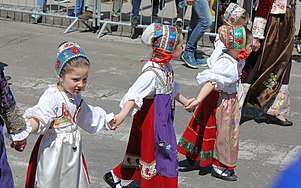 Children from Ovodda
Children from Ovodda.jpg) Urthos mask of Fonni
Urthos mask of Fonni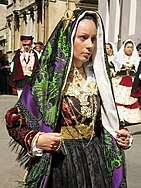 Robes from Maracalagonis
Robes from Maracalagonis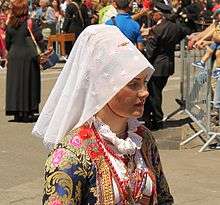 Woman from Ollolai
Woman from Ollolai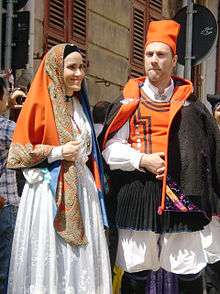 Robes from Cagliari
Robes from Cagliari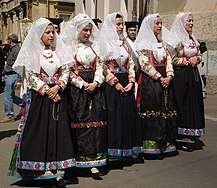 Robes from Busachi
Robes from Busachi- Robes from Olbia
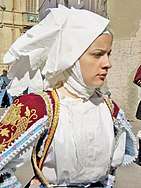 Robe from Sennori
Robe from Sennori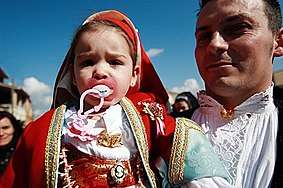 Robe from Oristano
Robe from Oristano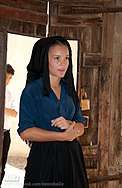 Daily traditional clothe from Dorgali
Daily traditional clothe from Dorgali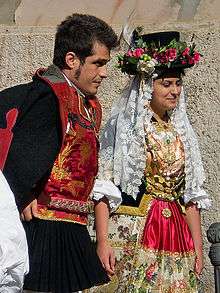 Folk robes from Quartu Sant'Elena
Folk robes from Quartu Sant'Elena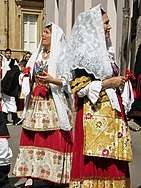 Robes from Selargius
Robes from Selargius- Robes from Assemini
- Child from Aritzo
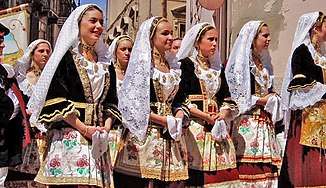 Women dressed in traditional Sardinian clothing (Quartucciu)
Women dressed in traditional Sardinian clothing (Quartucciu)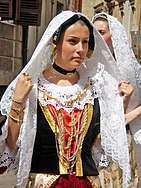 Robes from Settimo San Pietro
Robes from Settimo San Pietro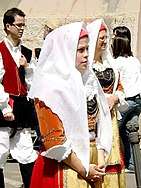 Robe from Dolianova
Robe from Dolianova.jpg) Men from Lanusei
Men from Lanusei Robe from Nuragus
Robe from Nuragus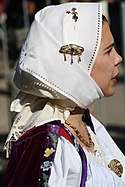 Robe from Bultei
Robe from Bultei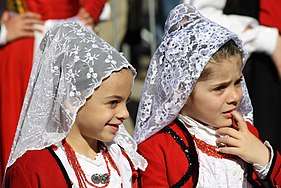 children from Villanova Monteleone
children from Villanova Monteleone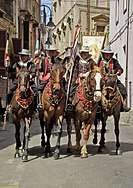 Knights from Teulada
Knights from Teulada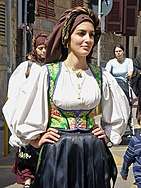 Traditional robe from Laconi
Traditional robe from Laconi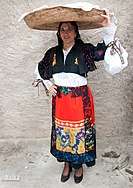 Robe from Tonara
Robe from Tonara.jpg) Robes from Fonni
Robes from Fonni.jpg) Man from Lanusei
Man from Lanusei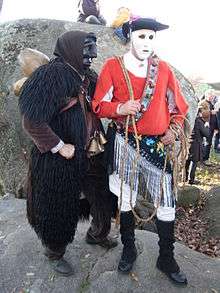 A Mamuthone and an Issohadore, traditional carnival garments from Mamoiada
A Mamuthone and an Issohadore, traditional carnival garments from Mamoiada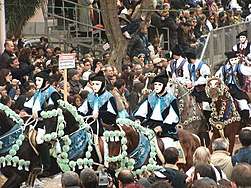 Sardinian knights on Sa Sartiglia day (Oristano).
Sardinian knights on Sa Sartiglia day (Oristano)..jpg) People in traditional dress (Busachi)
People in traditional dress (Busachi)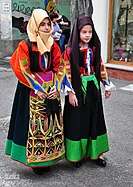 Robe from Orgosolo
Robe from Orgosolo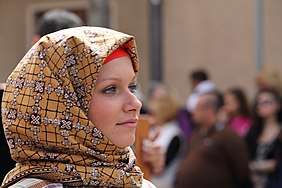 Robe from Iglesias
Robe from Iglesias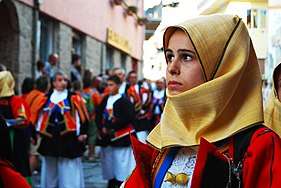 Orgosolo dress
Orgosolo dress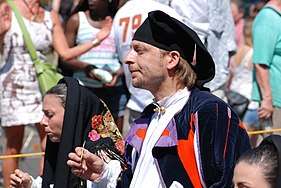 Robe from Oliena
Robe from Oliena Sartiglia Medieval Festival in Oristano
Sartiglia Medieval Festival in Oristano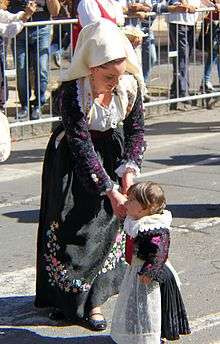 Robe from Florinas
Robe from Florinas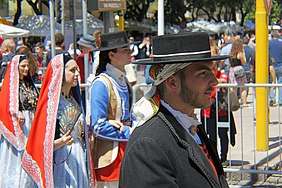 People from Cagliari
People from Cagliari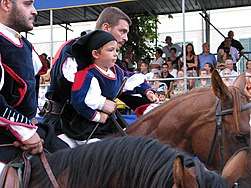 Sardinian men and children in traditional dress at the Sagra del Redentore (Nuoro)
Sardinian men and children in traditional dress at the Sagra del Redentore (Nuoro)- Children from Ovodda in traditional dress
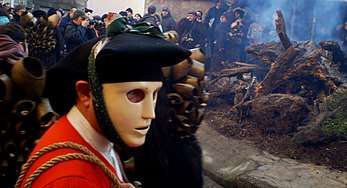 An Issohadore, typical mask of the Sardinian carnival (Mamoiada)
An Issohadore, typical mask of the Sardinian carnival (Mamoiada)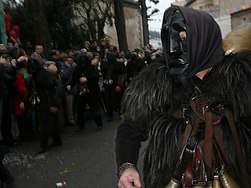 A Mamuthone, another typical mask of the Sardinian carnival (Mamoiada)
A Mamuthone, another typical mask of the Sardinian carnival (Mamoiada)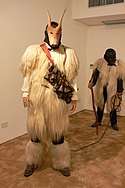 Boe and Merdule (Ottana)
Boe and Merdule (Ottana)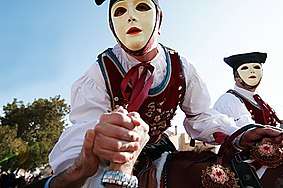 Mask of Sartiglia
Mask of Sartiglia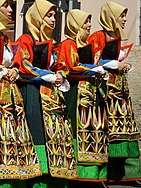 Sardinians in traditional dress (Orgosolo)
Sardinians in traditional dress (Orgosolo)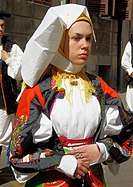 Robe from Atzara
Robe from Atzara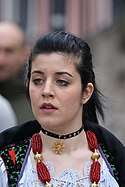 Robe from Oliena
Robe from Oliena- Robe from Orune
- Man from Austis
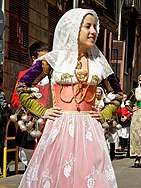 Robe from Ittiri
Robe from Ittiri.jpg) Woman from Fonni
Woman from Fonni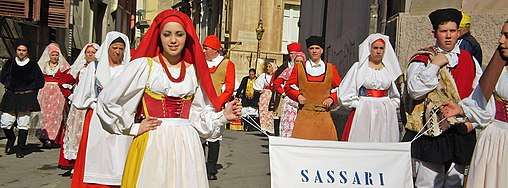 Robe from Sassari
Robe from Sassari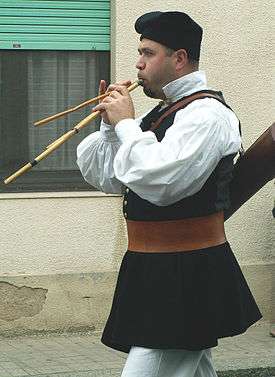 Sardinian man in traditional dress playing the Launeddas
Sardinian man in traditional dress playing the Launeddas Robe from Cossoine
Robe from Cossoine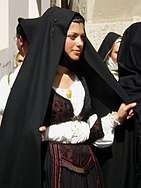 Robe from Isili
Robe from Isili
See also
| Wikimedia Commons has media related to People of Sardinia. |
- List of Sardinians
- Sardinia
- History of Sardinia
- Nuragic civilization
- List of Nuragic tribes
- Sardinian language
- Sassarese
- Gallurese
- Corsican people
- Italian people
References
- Historia de la isla de Cerdeña, por el caballero G. de Gregory, traducida al castellano por una sociedad literaria (1840). Barcelona: Imprenta de Guardia Nacional.
- Murru Corriga, Giannetta (1977). Etnia, lingua, cultura : un dibattito aperto in Sardegna. EDES.
- Sanna, Natale (1986). Il cammino dei Sardi: Storia, economia, letteratura ed arte di Sardegna (3 Volumes). Ed.Sardegna.
- Gonen, Amiram (1996). Diccionario de los pueblos del mundo. Anaya&Mario Muchnik.
- Casula, Francesco Cesare (1994). La Storia di Sardegna. Sassari: Carlo Delfino Editore.
- Brigaglia, Manlio; Giuseppina Fois; Laura Galoppini; Attilio Mastino; Antonello Mattone; Guido Melis; Piero Sanna; Giuseppe Tanda (1995). Storia della Sardegna. Sassari: Soter Editore.
- Perra, Mario (1997). ΣΑΡΔΩ, Sardinia, Sardegna (3 Volumes). Oristano: S'Alvure.
- Floris, Giovanni (1998). L'uomo in Sardegna : aspetti di antropobiologia ed ecologia umana. Sestu: Zonza.
- Ugas, Giovanni (2006). L'Alba dei Nuraghi. Cagliari: Fabula Editore. ISBN 978-88-89661-00-0.
- Sanna, Emanuele (2009). Nella preistoria le origini dei Sardi. Cagliari: CUEC.
- Cole, Jeffrey (2011). Ethnic Groups of Europe: an Encyclopedia. ABC-CLIO. ISBN 978-1-59884-302-6.
- Danver, Steven Laurence. Native peoples of the world: An Encyclopedia of Groups, Cultures, and Contemporary Issues. Routledge. ISBN 978-0765682222..
- Contu, Ercole (2014). I sardi sono diversi. Carlo Delfino Editore.
- Onnis, Omar (2015). La Sardegna e i sardi nel tempo. Arkadia Editore.
- Ugas, Giovanni (2017). Shardana e Sardegna : i popoli del mare, gli alleati del Nordafrica e la fine dei grandi regni (15.-12. secolo a.C.) (in Italian). Cagliari: Edizioni della Torre. ISBN 978-88-7343-471-9. OCLC 970796519.
- Casula, Francesco Cèsare (2017). La Storia di Sardegna (8 Volumes). Sassari: La Nuova Sardegna.
Notes
- Statistiche demografiche ISTAT
- Introduced in the 18th century and then spread as a result of a language shift; Italian is usually spoken either in the standard variety with a Sardinian accent or more commonly in a regional variety.
- Including Sassarese and Gallurese, linguistically transitioning to Southern Corsican and often colloquially considered to be northern Sardinian varieties.
- Sardinia, Lonely Planet, Damien Simonis
- Sardinians – World Directory of Minorities
- Sard. Oxford Dictionary.
- Minahan, James (2000). One Europe, Many Nations: A Historical Dictionary of European National Groups. Greenwood Publishing Group. p. 588. ISBN 0313309841.
The Sards are a Romance people
- Minahan, James (2000). One Europe, Many Nations: A Historical Dictionary of European National Groups. Greenwood Publishing Group. p. 776. ISBN 0313309841.
Romance (Latin) nations... Sards
- <<Sardi: indigeni, qui in Sardinia nati sunt.>> Robert Estienne, 1583, Dictionarium, seu Latinae linguae Thesaurus, Robert Estienne, Q-Z, v.III
- Danver, Steven L. Native Peoples of the World: An Encyclopedia of Groups, Cultures and Contemporary Issues, pp.370-371
- Lang, Peter; Petricioli, Marta. L’Europe Méditerranéenne, pp.201-254,
- Attilio Mastino. "Natione Sardus: una mens, unus color, una vox, una natio" (PDF). Rivista Internazionale di Scienze Giuridiche e Tradizioni Romane.
- Edelsward, Lisa-Marlene; Salzman, Philip (1996). Sardinians - Encyclopedia of World Cultures
- Cole, Jeffrey. Ethnic Groups of Europe: An Encyclopedia, pp.321-325
- "Tempio-Altare di monte d'Accoddi". SardegnaTurismo.
- <<Sull'origine del popolo sardo le fonti classiche non riescono a darci che poche e scarse notizie, la cui interpretazione non è affatto facile.>> Sanna, Natale (1986). Il cammino dei Sardi: storia, economia, letteratura ed arte di Sardegna, I, Ed.Sardegna, Cagliari, p.19
- "Sardinia". Online Etymology Dictionary.
- "Sardi in Dizionario di Storia (2011)". Treccani.
- I.E.S. Edwards , C.J. Gadd , N.G.L. Hammond , E.Sollberger (edited by). 1970. The Cambridge Ancient History, Volume II, Part 2, Cambridge University Press, p.369
- La stele di Nora contiene la lingua sarda delle origini, Salvatore Dedola
- Platonis dialogi, scholia in Timaeum (edit. C. F. Hermann, Lipsia 1877), 25 B, pag. 368
- Pittau, Massimo (1981). La Lingua dei Sardi Nuragici e degli Etruschi, Sassari, p. 57
- Sanna, Emanuele (2009). Nella preistoria le origini dei sardi, CUEC, Cagliari, p.76
- "Sardus, ut inquit Pausanias, filius fuit Maceridis, qui apud Aegyptios et Libyes, Libyes Hercules dicebatur, et Delphos aliquando petiit." Fara, Francesco Giovanni (1580). De Rebus Sardois, Libri quatuor, 1835 - 1580, Turin, p.106
- Lipiński, Edward (1995). Dieux et déesses de l'univers phénicien et punique, Peeters Publishers, p. 368
- Attilio Mastino (2015). "L'iscrizione latina del restauro del tempio del Sardus Pater ad Antas e la problematica istituzionale".
- Casula, Francesco Cèsare (2017). La storia di Sardegna, I, Evo Antico Sardo : Dalla Sardegna Medio-Nuragica (100 a.C. c.) alla Sardegna Bizantina (900 d.C. c.), p.92
- Bartoloni, Piero (2009). I Fenici e i Cartaginesi in Sardegna, C. Delfino, Sassari, p.130
- Sallust, Historiae, II, fr.4
- Pausanias, Ελλάδοσ περιήγησισ, X, 17
- Silius Italicus, Punica, XII, 360
- Gaius Julius Solinus, Collectanea rerum memorabilium, IV, 1
- Isidore of Seville, XIV, Etymologiae, Thapsumque iacentem, 39
- Serra, Marcello (1978). Enciclopedia della Sardegna : con un saggio introduttivo intitolato Alla scoperta dell'isola, Pisa, Giardini editori e stampatori, p.29: "Origine e carattere dei Sardi"
- E. De Rougè (1867), Révue Archéologique, XVI, p.35 ff.
- F. J. Chabas (1872), Étude sur l'antiquité historique d'après les sources égyptiennes et les monuments réputés préhistoriques, impr. de J. Dejussieu (Chalon-sur-Saône), p.191-192, 314
- "I monumenti dell'Egitto che hanno di già sparsa tanta luce sulla storia dell'antico oriente, sarebbero quelli i quali, secondo un'opinione recentemente emessa da più di un dotto, farebbero anche il più antico ricordo dei Sardi." Pais, Ettore (1881). Sardegna prima del dominio romano: studio storico archeologico, Coi tipi del Salviucci, Roma, p.261
- Ugas, Giovanni (2017). Shardana e Sardegna : i popoli del mare, gli alleati del Nordafrica e la fine dei grandi regni (15.-12. secolo a.C.), Edizioni della Torre, Cagliari, pp.398-408
- Sardi in Enciclopedia Italiana (1936), Giacomo Devoto, Treccani
- Nuovo studio dell’archeologo Ugas: “È certo, i nuragici erano gli Shardana”
- Shardana, sardi nuragici: erano lo stesso popolo?, Interview with Giovanni Ugas (in Italian)
- "La certezza degli accademici egiziani: "Gli shardana erano i nuragici sardi"". SardiniaPost.
- Manlio Brigaglia – Storia della Sardegna, pg. 48-49-50
- Giovanni Ugas – L'alba dei Nuraghi , pg.22-23-24
- Lilliu, Giovanni; Alberto Moravetti (edited by). Cultura & culture : storia e problemi della Sardegna negli scritti giornalistici di Giovanni Lilliu, v.1, 1995, Delfino, Sassari, p.18-19
- Motzo, Bacchisio Raimondo (1933). Iliensi in Enciclopedia Italiana, cited in Treccani
- Iliensi, Enciclopedia on line Treccani
- Motzo, Bacchisio Raimondo (1933). Balari in Enciclopedia Italiana, cited in Treccani
- Giovanni Ugas – L'alba dei Nuraghi, p. 241
- SardiniaPoint.it – Interview with Giovanni Ugas, archaeologist and professor of the University of Cagliari (in Italian)
- Giovanni Ugas - L'Alba dei Nuraghi pg.241,254 - Cagliari, 2005
- Casula, Francesco Cèsare (2017). La storia di Sardegna, I, Evo Antico Sardo : Dalla Sardegna Medio-Nuragica (100 a.C. c.) alla Sardegna Bizantina (900 d.C. c.), p.110, 137-151
- E. Matisoo-Smith et al., Matisoo-Smith, E.; Gosling, A. L.; Platt, D.; Kardailsky, O.; Prost, S.; Cameron-Christie, S.; Collins, C. J.; Boocock, J.; Kurumilian, Y.; Guirguis, M.; Pla Orquín, R.; Khalil, W.; Genz, H.; Abou Diwan, G.; Nassar, J.; Zalloua, P. (2018). "Ancient mitogenomes of Phoenicians from Sardinia and Lebanon: A story of settlement, integration, and female mobility". PLOS One. PubMed Central. 13 (1): e0190169. Bibcode:2018PLoSO..1390169M. doi:10.1371/journal.pone.0190169. PMC 5761892. PMID 29320542.
- Manlio Brigaglia, Attilio Mastino, Gian Giacomo Ortu (edited by). Storia della Sardegna, dalle Origini al Settecento, p. 41
- Casula, Francesco Cèsare (2017). La storia di Sardegna, I, Evo Antico Sardo : Dalla Sardegna Medio-Nuragica (100 a.C. c.) alla Sardegna Bizantina (900 d.C. c.), p.184
- Emmanuel Anati (ed. by). I sardi : la Sardegna dal paleolitico all'eta romana, Editrice Mediterranea, Cagliari, p.21
- [44] Neque ego, cum de vitiis gentis loquor, neminem excipio; sed a me est de universo genere dicendum, in quo fortasse aliqui suis moribus et humanitate stirpis ipsius et gentis vitia vicerunt. Magnam quidem esse partem sine fide, sine societate et coniunctione nominis nostri res ipsa declarat. Quae est enim praeter Sardiniam provincia quae nullam habeat amicam populo Romano ac liberam civitatem? . Cicero, Pro Scauro
- Casula, Francesco Cèsare (2017). La storia di Sardegna, I, Evo Antico Sardo : Dalla Sardegna Medio-Nuragica (100 a.C. c.) alla Sardegna Bizantina (900 d.C. c.), p.186
- «..Nello stesso tempo i Sardi rimasti indipendenti sulle montagne smisero il loro iniziale atteggiamento ostile nei confronti dei Cartaginesi, dei quali divennero federati, come dimostra il fatto che essi non si sollevarono contro i Punici nel momento in cui Scipione prese Olbia (259 a.C.), ma anzi fecero causa comune con quelli. Ne sono indizio le numerose menzioni di trionfi romani su Cartaginesi e Sardi.» Gennaro Pesce. La vita quotidiana durante il periodo punico, in La società in Sardegna nei secoli. p. 52.
- Roppa, Andrea (2018). Kouremenos, Anna (ed.). Insularity and identity in the Roman Mediterranean. Oxbow Books. pp. 144–164.
- A. Mastino, Storia della Sardegna antica, p.173
- Manlio Brigaglia, Attilio Mastino, Gian Giacomo Ortu (edited by). Storia della Sardegna, dalle Origini al Settecento, p. 42
- Manlio Brigaglia, Attilio Mastino, Gian Giacomo Ortu (edited by). Storia della Sardegna, dalle Origini al Settecento, pp. 41, 43-45
- Contini & Tuttle, 1982: 171; Blasco Ferrer, 1989: 14.
- Story of Language, Mario Pei, 1949
- Romance Languages: A Historical Introduction, Cambridge University Press
- Manlio Brigaglia, Attilio Mastino, Gian Giacomo Ortu (edited by). Storia della Sardegna, dalle Origini al Settecento, p. 44
- Casula, Francesco Cèsare (2017). La storia di Sardegna, I, Evo Antico Sardo : Dalla Sardegna Medio-Nuragica (100 a.C. c.) alla Sardegna Bizantina (900 d.C. c.), pp. 255-269
- Francesco Cesare Casula – La Storia di Sardegna, pg.141
- Casula, Francesco Cèsare (1982). Profilo storico della Sardegna catalano-aragonese, Edizioni della Torre, Cagliari, pp.8-10 ; Casula, Francesco Cèsare (1985). La Sardenya catalano-aragonesa : perfil historic, Dalmau, Barcelona, p.14
- Cèsare, Francesco Cèsare (1985). La Sardenya catalano-aragonesa : perfil historic, Dalmau, Barcelona, p.19
- Casula, Francesco Cèsare (1990). La Sardegna aragonese, 6.2 La nazione sarda, Sassari, Chiarella
- Manlio Brigaglia – Storia della Sardegna , pg.158
- Minority Rights Group International – Sardinians
- Stranieri nella Cagliari del XVI e XVII secolo da "Los Otros: genti, culture e religioni diverse nella Sardegna spagnola”, Cagliari, 23 aprile 2004.
- Antonio Budruni, Da vila a ciutat: aspetti di vita sociale in Alghero, nei secoli XVI e XVII
- Carlo Maxia, Studi Sardo-Corsi, Dialettologia e storia della lingua fra le due isole
- Cardia, Amos (2006). S'italianu in Sardìnnia candu, cumenti e poita d'ant impostu: 1720-1848; poderi e lìngua in Sardìnnia in edadi spanniola , Iskra, Ghilarza, p. 92
- Dizionario geografico storico-statistico-commerciale degli Stati di S. M. il Re di Sardegna: 3, Volumes 1-28, Presso G. Maspero librajo, 1836, year 1738
- Stefano Musso, Tra fabbrica e società: mondi operai nell'Italia del Novecento, Volume 33, p.316
- Quando i bergamaschi occuparono le case Archived 12 November 2012 at the Wayback Machine
- Il progresso sociale della Sardegna e lo sfruttamento industriale delle miniere – Sardegnaminiere.it
- Roberto Almagia; et al. (1936). "Sardegna, in Enciclopedia Italiana". Treccani.
- Veneti nel Mondo (Venetians in the World) – Anno III – numero 1 – Gennaio 1999 (in Italian)
- E al ritorno conquistarono le terre abbandonate – La Nuova Sardegna
- Sardinia Travel Guide, Eupedia.com
- ISTAT Numero medio di figli per donna per regione 2002–2005
- Solo 1,1 figli per madre, la Sardegna ultima in Italia - La Nuova Sardegna
- ISTAT Tassi generici di natalità, mortalità e nuzialità per regione 2002–2005
- Rapporto Istat – La popolazione straniera residente in Italia al 31º dicembre 2013
- ISTAT - Indicatori demografici anno 2015, p.6
- Sardinia, Italy – Blue Zones
- Okinawa Exploration Backgrounds – Blue Zones
- Does Sardinia hold the secret of long life - mystery, The Guardian
- Francesco Cucca: “Caratteri immutati da diecimila anni, ecco perché la Sardegna è speciale” (di Elena Dusi) - Sardegna Soprattutto
- Sardinia Exploration Backgrounds – Blue Zones
- Polidori MC, Mariani E, Baggio G, et al. (July 2007). "Different antioxidant profiles in Italian centenarians: the Sardinian peculiarity". Eur J Clin Nutr. 61 (7): 922–4. doi:10.1038/sj.ejcn.1602596. PMID 17228351.
- Susan Pinker: why face-to-face contact matters in our digital age – The Guardian
- ISTAT Tassi generici di natalità, mortalità e nuzialità per regione 2002–2005
- ISTAT Numero medio di figli per donna per regione 2002–2005
- Ministero della Salute Speranza di vita e mortalità Archived 20 October 2009 at the Wayback Machine
- Matrimoni, Il processo di secolarizzazione in Sardegna - Sardinian Socio-Economic Observatory
- Isola prima in Italia per suicidi, Ansa.it
- Sardegna, il paradiso dei suicidi, Sardegna Dìes
- La Sardegna prima in Italia nella classifica dei suicidi, La Nuova Sardegna
- Analfabetismo Italia – Censimento 2001
- Sardegna Statistiche: Analfabeti
- Giuseppe Sanna – L'emigrazione della Sardegna (Emigration of Sardinia) (in Italian)
- L'emigrazione sarda tra la fine dell' 800 e i primi del 900
- http://lipari.istat.it/digibib/Annuari/TO00176482Annuario_statistico_emigrazione_italiana_1876_1925.pdf Commissariato generale dell'emigrazione (a cura di), Annuario statistico della emigrazione italiana dal 1876 al 1925
- Il messagero sardo – Una piccola ma attiva colonia di sardi vive nello stato di Bahia (in Italian)
- "Museo Nazionale Emigrazione Italiana – 25-03-2012". Archived from the original on 23 March 2015.
- "Le origini dei cognomi sardi, il primo Sanna aveva i canini affilati come zanne, Mauro Maxia".
- "Cognomi sardi. Piras, secondo nell'isola: le origini in villaggi dell'Ozierese e del Sulcis, Mauro Maxia".
- "I segreti dei cognomi. Cinquemila famiglie Pinna: tutto iniziò con la piuma e la penna di uno scrivano, Mauro Maxia".
- "Il cognome: Melis, dolce come il miele. La prima apparizione risale al 1200 nel Regno di Arborea, Mauro Maxia".
- I Sanna battono i Piras: è loro il cognome più diffuso in Sardegna. Ecco la classifica - La Nuova Sardegna
- Cognomi | I più diffusi in Sardegna per territorio - Sardinian Socio-Economic Observatory
- Manconi, Lorenzo (1987). Dizionario dei cognomi sardi, Edizioni della Torre, p.15
- Rivista italiana di onomastica, Mauro Maxia, Cognomi sardi medioevali formati da toponimi
- "All'origine di Piga c'è la gazza non la lentiggine". La Nuova Sardegna.
- Manconi, Lorenzo (1987). Dizionario dei cognomi sardi, Edizioni della Torre, p.16
- Pittau, Massimo, 2014. I cognomi della Sardegna: Significato e origine di 8.000 cognomi indigeni e forestieri, Ipazia Books
- Manconi, Lorenzo (1987). Dizionario dei cognomi sardi, Edizioni della Torre, p.12
- Le origini dei cognomi sardi, dai colori agli animali, La Nuova Sardegna
- Maxia, Mauro (2002). Dizionario dei cognomi sardo-corsi. Frequenze, fonti, etimologia, Condaghes, ISBN 978-88-7356-005-0
- "Cognomi sardi, Cossu: breve, antico e con un'infinità di complicazioni". La Nuova Sardegna.
- "I segreti dei cognomi sardi: Cossiga è glorioso e raro. Ma l'accento andrebbe sulla o". La Nuova Sardegna.
- "I segreti dei cognomi sardi: Achenza, viaggio dalla Corsica al Nord Sardegna". La Nuova Sardegna.
- Manconi, Lorenzo (1987). Dizionario dei cognomi sardi, Edizioni della Torre, p.13
- Bonamore, Daniele (2004). Lingue minoritarie, lingue nazionali, lingue ufficiali nella Legge 482/1999, Franco Angeli, Milano, pp.62-63
- The Scottish referendum: the view from Italy and Sardinia, Ilenia Ruggiu, Scottish Affairs 23.3 (2014): 407–414
- Gianmario Demuro; Ilenia Ruggiu; Francesco Mola (2013). Identità e Autonomia in Sardegna e Scozia. Maggioli Editore. pp. 26–28. ISBN 978-8838782435.
- L'esempio della Catalogna, i sardi sono più «identitari» - L'Unione Sarda; Sardi, i più «identitari», di Giuseppe Meloni; L’Unione Sarda, Fondazione Sardinia, 30.09.2015
- La Sardegna: lo stato delle cose fra “percepito” e ossatura reale, Istituto Ixè, Fondazione di Sardegna; Vissuto - identità, table n.44
- "L'Isola ha paura del futuro Fiducia solo sul turismo - Regione". 7 December 2017.
- Bolognesi, Roberto (1998). The Phonology of Campidanian Sardinian: A Unitary Account of a Self-Organizing Structure. Holland Academic Graphics.
- Cardia, Amos (2006). S'italianu in Sardìnnia candu, cumenti e poita d'ant impostu: 1720-1848; poderi e lìngua in Sardìnnia in edadi spanniola, Iskra, Ghilarza, pp. 88, 91
- Settecento sardo e cultura europea: Lumi, società, istituzioni nella crisi dell'Antico Regime; Antonello Mattone, Piero Sanna; FrancoAngeli Storia; pp.18
- Salvi, Sergio (1974). Le lingue tagliate, Rizzoli, pg.181
- "Limba Sarda 2.0S'italianu in Sardigna? Impostu a òbligu de lege cun Boginu – Limba Sarda 2.0". Limba Sarda 2.0. Retrieved 28 November 2015.
- "La limba proibita nella Sardegna del '700 da Ritorneremo, una storia tramandata oralmente". Retrieved 28 November 2015.
- «come conseguenza dell’italianizzazione dell’isola – a partire dalla seconda metà del XVIII secolo ma con un’accelerazione dal secondo dopoguerra – si sono verificati i casi in cui, per un lungo periodo e in alcune fasce della popolazione, si è interrotta la trasmissione transgenerazionale delle varietà locali. [...] Potremmo aggiungere che in condizioni socioeconomiche di svantaggio l’atteggiamento linguistico dei parlanti si è posto in maniera negativa nei confronti della propria lingua, la quale veniva associata ad un’immagine negativa e di ostacolo per la promozione sociale. [...] Un gran numero di parlanti, per marcare la distanza dal gruppo sociale di appartenenza, ha piano piano abbandonato la propria lingua per servirsi della lingua dominante e identificarsi in un gruppo sociale differente e più prestigioso.» Gargiulo, Marco (2013). La politica e la storia linguistica della Sardegna raccontata dai parlanti, in Lingue e diritti. Lingua come fattore di integrazione politica e sociale, Minoranze storiche e nuove minoranze, Atti a cura di Paolo Caretti e Andrea Cardone, Accademia della Crusca, Firenze, pp. 132-133
- Floris, Giovanni (1998). L'uomo in Sardegna : aspetti di antropobiologia ed ecologia umana, Sestu, Zonza, Distribuzione delle frequenze fenotipiche del sistema AB0 in diversi gruppi linguistici, p.206
- Danver, Steven. Native peoples of the world - An Encyclopedia of Groups, Cultures, and Contemporary Issues
- Eduardo Blasco Ferrer, ed. 2010. Paleosardo: Le radici linguistiche della Sardegna neolitica (Paleosardo: The Linguistic Roots of Neolithic Sardinian). De Gruyter Mouton
- Martin Maiden, John Charles Smith, Adam Ledgeway (edited by). The Cambridge History of the Romance Languages: Volume II, Contexts, Cambridge University Press, 2013, p.167
- Giannetta Murru Corriga (edited by), 1977. Etnia, lingua, cultura : un dibattito aperto in Sardegna, EDES, Tradizione, identità e cultura sarde nella scuola, Giovanni Lilliu, pp.128-131
- Raffaele Simone (2009). "Lingue in Il Libro dell'Anno". Treccani.
- <<Nel 1948 la Sardegna diventa, anche per le sue peculiarità linguistiche, Regione Autonoma a statuto speciale. Tuttavia a livello politico, ufficiale, non cambia molto per la minoranza linguistica sarda, che, con circa 1,2 milioni di parlanti, è la più numerosa tra tutte le comunità alloglotte esistenti sul territorio italiano...>>. De Concini, Wolftraud (2003). Gli altri d'Italia : minoranze linguistiche allo specchio, Pergine Valsugana : Comune, p.196.
- Bonamore, Daniele (2004). Lingue minoritarie, lingue nazionali, lingue ufficiali nella Legge 482/1999, Franco Angeli, Milano, pp.96-98
- Lingue di minoranza e scuola: Sardo
- Legislazione sulle altre minoranze linguistiche, Sardegna Cultura
- Manuale di linguistica sarda (Manual of Sardinian linguistics), 2017, Ed. by Eduardo Blasco Ferrer, Peter Koch, Daniela Marzo. Manuals of Romance Linguistics, De Gruyter Mouton, pp.208
- Cited in Lilliu, Giovanni; Alberto Moravetti (edited by). Cultura & culture : storia e problemi della Sardegna negli scritti giornalistici di Giovanni Lilliu, v.2, 1995, Delfino, Sassari, p.445
- La Nuova Sardegna, 04/11/10, Per salvare i segni dell'identità – di Paolo Coretti
- Piras, Luciano (5 February 2019). "Silanus diventa la capitale dei vocabolari dialettali". La Nuova Sardegna (in Italian).
- Sardinia, Lonely Planet, Damien Simonis, pg. 44
- UNESCO Interactive Atlas of the World’s Languages in Danger
- Floris, Giovanni (1998). L'uomo in Sardegna : aspetti di antropobiologia ed ecologia umana, Sestu, Zonza, Distribuzione delle frequenze fenotipiche del sistema AB0 in diversi gruppi linguistici, p.207
- <<[Sardinians] speak a peculiar language, Sardinian, and use it to write both in poetry and prose, especially in Logudoro where it has been kept purer, and more elegant and rich. And, since many Spaniards, both Aragonese and Catalan, and Italians immigrated to Sardinia, and keep doing so in order to trade, Spanish, Catalan and Italian are also spoken; so, a single people is able to hold a conversation in all these languages. However, those from Cagliari and Alghero usually speak their masters' language, Catalan, whilst the other people retain the genuine language of the Sardinians.>> Original text: <<[Sardi] Loquuntur lingua propria sardoa, tum ritmice, tum soluta oratione, praesertim in Capite Logudorii, ubi purior copiosior, et splendidior est. Et quia Hispani plures Aragonenses et Cathalani et Itali migrarunt in eam, et commerciorum caussa quotidie adventant, loquuntur etiam lingua hispanica et cathalana et italica; hisque omnibus linguis concionatur in uno eodemque populo. Caralitani tamen et Algharenses utuntur suorum maiorum lingua cathalana; alii vero genuinam retinent Sardorum linguam.>> Fara, Francesco Giovanni (1580). De Rebus Sardois, De natura et moribus Sardorum ("On the Sardinian things, On the Nature and Customs of the Sardinians"), 1835 - 1580, Turin, p. 51
- Sassarese Sardinian, Ethnologue
- Gallurese Sardinian, Ethnologue
- B. Fois, The crest of the four Moors, brief history of the Sardinian emblem, Carlo Delfino, Sassari 1990
- Onnis, Omar (2015). La Sardegna e i sardi nel tempo, Arkadia, Cagliari, pp.150-151
- Alberto Loni e Giuliano Carta. Sa die de sa Sardigna - Storia di una giornata gloriosa. Sassari, Isola editrice, 2003.
- Massimo Pistis, Rivoluzionari in sottana. Ales sotto il vescovado di mons. Michele Aymerich, Roma, Albatros Il Filo, 2009.
- Adriano Bomboi, L'indipendentismo sardo. Le ragioni, la storia, i protagonisti, Cagliari, Condaghes, 2014.
- Sa die de sa Sardigna, Sardegna Cultura
- "Religious observances, Aspects of daily life, Regions and type of municipality". ISTAT. 20 March 2016. Retrieved 20 March 2016.
- Arata, Giulio Ulisse (1983). Arte sarda, C. Delfino, Sassari, p.11
- Arata, Giulio Ulisse (1983). Arte sarda, C. Delfino, Sassari, p.27
- Mario Atzori (ed. by), 2000, Gli ornamenti preziosi dei sardi, Sassari, C. Delfino, p.31
- Costumi: storia, linguaggio e prospettive del vestire in Sardegna (2003). Ilisso, Nuoro, p.53
- "I maestri dell'arte sarda, Filippo Figari: la civiltà di un popolo barbaro". Cfr. AA.VV., I maestri dell'arte sarda, 10 vv., La Nuova Sardegna, 2020
- Costumi: storia, linguaggio e prospettive del vestire in Sardegna (2003). Ilisso, Nuoro, p.20
- "Olim Sardi vestiebantur caprarum pellibus, veterum Graecorum more, ut inquit Alexander Sardus lib. 1, cap. 9 de Moribus Gentium. Nam et Hercules, a quo originem duxerunt, pelle etiam vestiebatur. Illis tamen utebantur hyeme, pilis introrsum conversis; aestate vero, aversis, ut inquit Nymphodorus, quem refert Volaterramus, eamque tunicam sardonicam vocat Caelius, lib. 16, cap. 1 o, et Sardorum mastrucam appellat Cicero et Divus Hieronymus lib. Adversus Luciferianos. Unde Sardi Mastrucati sunt dicti a Cicerone, et Pelidi a Sabellico, post Livium lib. 23 et 29, qui, alibi refert, anno ante Christum 3757 , fuisse a Sardis Romano exercitui data duodecim millia tunicarum, et mille et ducentae togae." Fara, Francesco Giovanni (1580). De Rebus Sardois, Libri quatuor, 1835 - 1580, Turin, p.51
- Olivieri, A; Sidore, C; Achilli, A; Angius, A; Posth, C; Furtwängler, A; Brandini, S; Capodiferro, MR; Gandini, F; Zoledziewska, M; Pitzalis, M; Maschio, A; Busonero, F; Lai, L; Skeates, R; Gradoli, MG; Beckett, J; Marongiu, M; Mazzarello, V; Marongiu, P; Rubino, S; Rito, T; Macaulay, V; Semino, O; Pala, M; Abecasis, GR; Schlessinger, D; Conde-Sousa, E; Soares, P; Richards, MB; Cucca, F; Torroni, A (2017). "Mitogenome Diversity in Sardinians: A Genetic Window onto an Island's Past". Mol Biol Evol. 34 (5): 1230–1239. doi:10.1093/molbev/msx082. PMC 5400395. PMID 28177087.
- Gabriella Grimaldi. "Il dna dei sardi è unico in Europa, è lo stesso dei loro avi nuragici". La Nuova Sardegna.
- Luigi Luca Cavalli-Sforza, Paolo Menozzi, Alberto Piazza - The History and Geography of Human Genes, 1994, Princeton University Press, pp.272
- Marcus et al.,Population history from the Neolithic to present on the Mediterranean island of Sardinia: An ancient DNA perspective, 2019
- "Ancient DNA from Sardinia reveals 6,000 years of genetic history, Science Daily". 2020.; "Genetic history from the Middle Neolithic to present on the Mediterranean island of Sardinia". Nature. 2020.
- Genetica, malattie e caratteri dei sardi, Francesco Cucca - Sardegna Ricerche
- I dialoghi della scienza di Sardegna Ricerche: "I sardi hanno caratteristiche genetiche uniche"
- The sardinians' dna, a key to explain human illness
- Diabetes Mellitus (DM) - Endocrine and Metabolic Disorders - MSD Manual
- Floris, Giovanni (1998). L'uomo in Sardegna : aspetti di antropobiologia ed ecologia umana, Sestu, Zonza, Sull'evoluzione dei Sardi dalla Preistoria ad oggi, p.13
- Rosati, G; Aiello, I; Pirastru, MI; Mannu, L; Sanna, G; Sau, GF; Sotgiu, S (1996). "Epidemiology of multiple sclerosis in Northwestern Sardinia: further evidence for higher frequency in Sardinians compared to other Italians". Neuroepidemiology. 15 (1): 10–9. doi:10.1159/000109884. PMID 8719044.
- Sotgiu, S; Pugliatti, M; Sanna, A; Sotgiu, A; Castiglia, P; Solinas, G; Dolei, A; Serra, C; Bonetti, B; Rosati, G (2002). "Multiple sclerosis complexity in selected populations: the challenge of Sardinia, insular Italy". Eur J Neurol. 9 (4): 329–41. doi:10.1046/j.1468-1331.2002.00412.x. PMID 12099914.
- Olivieri, A.; Sidore, C.; Achilli, A.; Angius, A.; Posth, C.; Furtwängler, A.; Brandini, S.; Capodiferro, M.R.; Gandini, F.; Zoledziewska, M. (2017). "Mitogenome diversity in Sardinians: A genetic window onto an island's past". Mol. Biol. Evol. 34: 1230–1239. doi:10.1093/molbev/msx082.
- Lettre, G.; Hirschhorn, J. N. (2015). "Small island, big genetic discoveries". Nat. Genet. 47: 1224–1225. doi:10.1038/ng.3426.
- Cavalli-Sforza, Luigi; Cavalli-Sforza, Luca; Menozzi, Paolo; Piazza, Alberto (1994). The History and Geography of Human Genes. Princeton University Press. p. 273 ff.
- Genome flux and stasis in a five millennium transect of European prehistory
- Keller at al 2011, Nature
- Mathieson et al 2015, Nature
- supp. info (p.16)
- A Common Genetic Origin for Early Farmers from Mediterranean Cardial and Central European LBK Cultures, Olalde et al 2015, Molecular Biology and Evolution
- Gamba et al 2014, Genome flux and stasis in a five millennium transect of European prehistory, Nature
- Omrak et al 2016, Genomic Evidence Establishes Anatolia as the Source of the European Neolithic Gene Pool, Current Biology, Volume 26, Issue 2, p270–275, 25 January 2016
- Haak et al 2015, Massive migration from the steppe was a source for Indo-European languages in Europe
- supp. info (p.120)
- Reference Populations Genographic Project. National Geographic
- Dayna L. Dreger, Brian W. Davis, Raffaella Cocco, Sara Sechi, Alessandro Di Cerbo, Heidi G. Parker, Michele Polli, Stefano P. Marelli, Paola Crepaldi and Elaine A. Ostrander (2016). "Commonalities in Development of Pure Breeds and Population Isolates Revealed in the Genome of the Sardinian Fonni's Dog". Genetics.CS1 maint: multiple names: authors list (link)
- "Nel genoma del cane da pastore fonnese la storia dei sardi". La Nuova Sardegna. 2016.
- Jane Brackman. "Genome of Sardinian Sheepdog Provides Insight into Human Migration Patterns".
- M. Gallego Llorente et al., 2018, Ancient Ethiopian genome reveals extensive Eurasian admixture in Eastern Africa, Science
- Fernandes, Daniel M. (21 March 2019). "The Arrival of Steppe and Iranian Related Ancestry in the Islands of the Western Mediterranean". bioRxiv. Retrieved 11 August 2020.
- High Differentiation among Eight Villages in a Secluded Area of Sardinia Revealed by Genome-Wide High Density SNPs Analysis
- Y-chromosome and Surname Analyses for Reconstructing Past Population Structures: The Sardinian Population as a Test Case, International Journal of Molecular Sciences
- Genome-wide scan with nearly 700 000 SNPs in two Sardinian sub-populations suggests some regions as candidate targets for positive selection
- Chiang et al., Using whole-genome sequencing to shed insight on the complex prehistory of Sardinia
- Il Dna sardo è il più vario d'Europa Ricerca sugli abitanti di Benetutti – Unione Sarda
- Italiani, i più ricchi in Europa … di diversità genetica – Uniroma
- Gli italiani sono il popolo con la varietà genetica più ricca d'Europa – La Repubblica
- D. Contu, L. Morelli, F. Santoni, J.W. Foster, P. Francalacci, F. Cucca (2008). "Y-chromosome based evidence for pre-neolithic origin of the genetically homogenous but diverse Sardinian population; inference for association scans". PloS ONE, Jan 9, 3(1): e1430
- Di Gaetano, Cornelia; Voglino, Floriana; Guarrera, Simonetta; Fiorito, Giovanni; Rosa, Fabio; Di Blasio, Anna Maria; Manzini, Paola; Dianzani, Irma; Betti, Marta; Cusi, Daniele; Frau, Francesca; Barlassina, Cristina; Mirabelli, Dario; Magnani, Corrado; Glorioso, Nicola; Bonassi, Stefano; Piazza, Alberto; Matullo, Giuseppe (2012). "An Overview of the Genetic Structure within the Italian Population from Genome-Wide Data". PLOS One. doi:10.1371/journal.pone.0043759.
- Di Gaetano, C; Fiorito, G; Ortu, MF; Rosa, F; Guarrera, S; Pardini, B; Cusi, D; Frau, F; Barlassina, C; Troffa, C; Argiolas, G; Zaninello, R; Fresu, G; Glorioso, N; Piazza, A; Matullo, G (2014). "Sardinians genetic background explained by runs of homozygosity and genomic regions under positive selection". PLOS One. 9 (3): e91237. Bibcode:2014PLoSO...991237D. doi:10.1371/journal.pone.0091237. PMC 3961211. PMID 24651212.
- Sidore, C., y colaboradores (2015). "Genome sequencing elucidates Sardinian genetic architecture and augments association analyses for lipid and blood inflammatory markers". Nature Genetics. 47 (11): 1272–1281. doi:10.1038/ng.3368. PMC 4627508. PMID 26366554.CS1 maint: multiple names: authors list (link)
